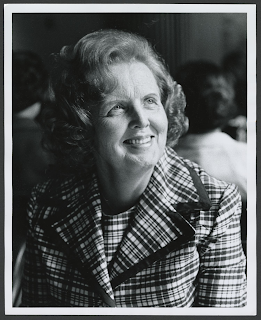Helen Corbitt and what Texans ate
 Helen Corbitt
Helen CorbittSome of you may remember I’vebeen off and on trying for three or four years to write a book about HelenCorbitt, legendary doyenne of food service at Neiman Marcus. My effort didn’t workfor a variety of reasons, one among them few people thought my idea was asinteresting as I did (hat tip to Travis Snyder of Texas Tech Press who did likethe idea). My thesis was and is that she came at an interesting time in thehistory of food in the US.
A native of upstate New York and a traineddietician, Corbitt came to Texas in 1940 to teach at the University of Texas atAustin. She was dismayed to find, as Prudence McIntosh wrote for TexasMonthly, “no artichokes, no fresh raspberries,no herbs except decorative parsley, only beef (chicken-fried, barbecued, orwell done), potatoes (fried or mashed and topped with a glop of cream gravy),and wedges of iceberg with sweet orange dressing. Fruit salad meant cannedpears or pineapple with a dollop of mayonnaise and a grating of cheddar cheese.Canned asparagus was a remarked-upon delicacy, as were Le Sueur canned peas.”
She moved on to the HoustonCountry Club, then a brief stint at Joske’s department store, and next theDriskill Hotel in Austin. Stanley Marcus began offering her a generous positionat Neiman’s long before1955, when she finally accepted.Meanwhile it was an era whenforces were encouraging women to get out of the kitchen, to shortcut cooking,use prepared food and modern appliances, free themselves from the drudgery ofthe apron. Food critic Poppy Cannon published The Can-Opener Cookbook in1951; Peg Bracken followed with The I Hate to Cook Cookbook in 1960.During the fifties, manufacturers were busy finding new consumers for preparedfood since the military no longer needed as many MREs, and appliance manufacturerscame up with appliances that practically prepared the entire meal. Futurists predictedhousewives would soon be able to put an entire meal on the table in less thanfifteen minutes.
Corbitt’s advice tohousewives, however, was “Get back in the kitchen.” (She actually saved at leastone marriage with that advice.) She believed in fresh ingredients, tasteful presentation,and careful combination of flavors. That chicken bouillon that is still servedin the Zodiac? It took hours of cooking. Her signature dish, marinated black-eyedpeas (also called Texas caviar) marinated at least two days before service.There was no instant food in her repertoire. One of her battles in her effortto teach Texans how to eat was the “al dente war”—she believed overcookingsapped vegetables of their flavor and health benefits. Everything from greenbeans to asparagus should be crisp. In a way, her cooking, rich with butter andcream, paved the way for James Beard and Julia Child.
Corbitt was a feisty, red-hairedIrish woman with a temper. Stories abound about her tenure at Neiman’s, herfriendships with everyone from President Lyndon B. Johnson and his Lady Bird to the Prince of Wales, her occasionalbursts of temper and outspoken moments.
Corbitt’s legacy lives on in herfive cookbooks, which are still in print. Yet today I doubt even Dallas residents,except those of my generation, recognize her name. In her retirement, shetraveled and lectured all over the South and Southwest, but she had almost notelevision presence, as Beard and Child did, and her reputation, while notlimited to Texas, was pretty much regional.
I still think her story isinteresting, and her accomplishments deserving of wider attention. Hmmm. The booksis not going to fly, but I have submitted an article to a historical magazine (thatthe fifties is historical still boggles my mind). And I’ll keep thinking ofways to tell Corbitt’s story. No, I don’t see a novel in it.
Want to try a recipe? Google HelenCorbitt’s marinated black-eyed peas. If recipes tell you to add a lot of vegetables,move on. Her recipes has peas and onions.



